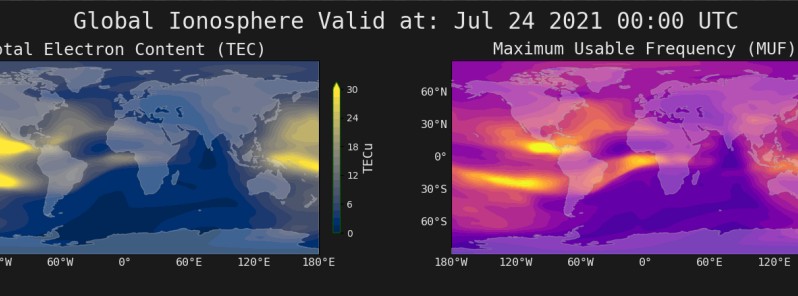Breakthrough computer model to provide better space weather forecasts

NOAA’s National Weather Service (NWS) has transitioned a new computer model into operations to increase its understanding of space weather events and improve space weather forecasting capabilities. These advances will help forecasters provide better information to the public about potential impacts from a solar storm and help mitigation actions across economic sectors, including communications, satellite and airline operations, human space flight, and navigation and surveying.
The first of its kind coupled Whole Atmosphere Model and Ionosphere Plasmasphere Electrodynamics Model (WAM-IPE Model) is now part of the Space Weather Prediction Center’s (SWPC) suite of forecast tools and has expanded space weather forecasts and services to include:
- The first time a forecast model will predict how Earth’s upper atmosphere will respond to solar and geomagnetic conditions as well as the perturbations from the lower atmosphere.
- Total Electron Content and Maximum Usable Frequency products are now operational. These are key for SWPC’s space weather advisories related to communication and navigation systems for the International Civil Aviation Organization’s global aviation space weather network.
- A new neutral-density product that could be used by satellite operators and ground-tracking systems for space traffic management. The real-time neutral density fields will be available for orbit prediction and space situational awareness purposes.
The WAM-IPE Forecast System (WFS) provides a specification of ionosphere and thermosphere conditions with forecasts two days in advance in response to solar, geomagnetic, and lower atmospheric forcing.
Model outputs are used at the Space Weather Forecast Office (SWFO) at SWPC for issuing warnings and alerts related to aviation communication and Global Navigation Satellite System (GNSS) scintillations. The real-time neutral density fields will also be available for orbit prediction and space traffic management purposes.
Global Ionosphere – The top two panels show the latest global Total Electron Content (TEC) and Maximum Usable Frequency (MUF) as forecasted by the WAM-IPE. The bottom two panels show the anomaly in TEC and MUF taking the difference between the latest values and a 10-day running average at the same universal time. The forecast is updated with the latest real-time and forecast solar and geomagnetic drivers at 0, 6, 12 and 18 UTC.
Neutral Atmosphere – The top plot shows the neutral density at 400 km and the bottom left plot shows the thermospheric column O/N2 ratio. The anomaly of neutral density at 400 km (250 miles) is shown in the bottom right plot, which is the percentage difference between the latest values and a 10-day running average at the same universal time. The forecast is updated with the latest real-time and forecast solar and geomagnetic drivers at 0, 6, 12 and 18 UTC.
"The new model will help our forecasters deliver better and more timely space weather forecasts and warnings, and it demonstrates NOAA’s commitment to advancing space weather forecasting," said Michael R. Farrar, director, NOAA’s National Center for Environmental Prediction. "The WAM-IPE Model will be an asset as we prepare for an increase in space weather expected during Solar Cycle 25."
The model will augment the existing WSA-ENLIL solar wind propagation model and the Geospace Model in SWPC operations, adding an important link in the "Sun-to-Earth" space weather modeling continuum. Space weather is caused by a series of interconnected events, beginning at the Sun and ending in the near-Earth space environment. Our ability to predict conditions and events in space depends on our understanding of these connections, and more importantly, our ability to predict the details.
NWS will continue to improve the WAM-IPE Model with plans to work with the larger space weather enterprise to incorporate data from satellites used in the COSMIC-2 and GOLD missions as well as other commercial satellite providers.
Featured image credit: SWPC

Commenting rules and guidelines
We value the thoughts and opinions of our readers and welcome healthy discussions on our website. In order to maintain a respectful and positive community, we ask that all commenters follow these rules.